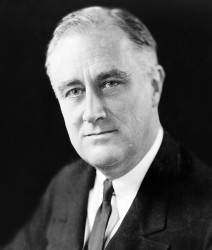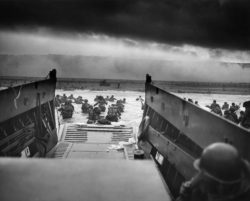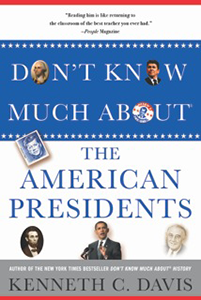President Franklin D. Roosevelt, “D-Day Prayer” in an announcement to the nation of the invasion of Normandy (June 6, 1944)

Franklin D. Roosevelt in 1933
My fellow Americans: Last night, when I spoke with you about the fall of Rome, I knew at that moment that troops of the United States and our allies were crossing the Channel in another and greater operation. It has come to pass with success thus far.
And so, in this poignant hour, I ask you to join with me in prayer:
Almighty God: Our sons, pride of our Nation, this day have set upon a mighty endeavor, a struggle to preserve our Republic, our religion, and our civilization, and to set free a suffering humanity.
Lead them straight and true; give strength to their arms, stoutness to their hearts, steadfastness in their faith.
They will need Thy blessings. Their road will be long and hard. For the enemy is strong. He may hurl back our forces. Success may not come with rushing speed, but we shall return again and again; and we know that by Thy grace, and by the righteousness of our cause, our sons will triumph.
They will be sore tried, by night and by day, without rest-until the victory is won. The darkness will be rent by noise and flame. Men’s souls will be shaken with the violences of war.
Franklin Roosevelt’s D-Day Prayer Source: Franklin D. Roosevelt Library and Museum

“Into the Jaws of Death – U.S. Troops wading through water and Nazi gunfire” by Robert F. Sergeant (National Archives)
In the largest amphibian assault in history, Allied armies crossed the English Channel to land on five beaches in Normandy in northern France. The invasion force involved 700 ships, 4,000 landing craft, 10,000 planes, and some 176,000 Allied troops from twelve countries. The allied forces were commanded by future President, Gen. Dwight D. Eisenhower.
The day was chaotic, brutal and bloody.
Steven Spielberg’s World War II epic, Saving Private Ryan, brought the reality of combat home to millions, but many moviegoers did not know which battle the film depicted, or when and why it happened. The assault, code-named Operation Overlord, occurred June 6, 1944, against Hitler’s Germany.
By the end of the day on June 6, 1944, the allies had taken all five beaches that had been targeted. The combined allied losses on that day have been recently stated at 4,415 dead, according to the National D-Day Memorial.
The German army did not formally surrender until May 7, 1945. May 8, 1945 was declared V.E. (Victory in Europe) Day.
More D-Day resources can be found at the FDR Library and Museum
Read more about FDR’s life and administration and World War II in Don’t Know Much About® History and Don’t Know Much About® the American Presidents


